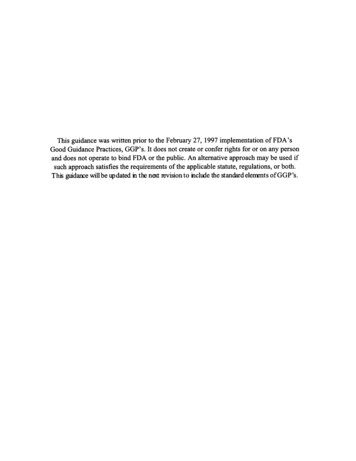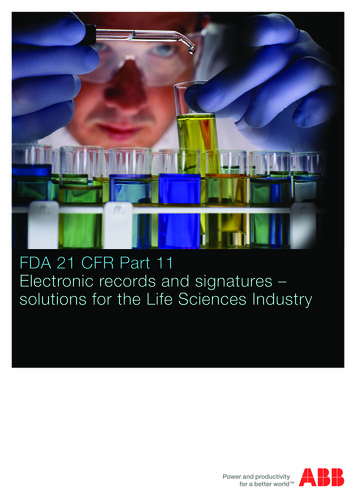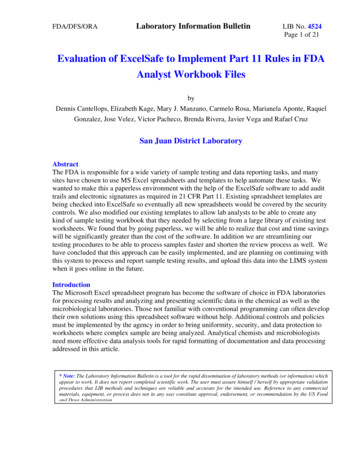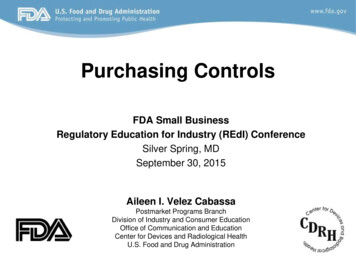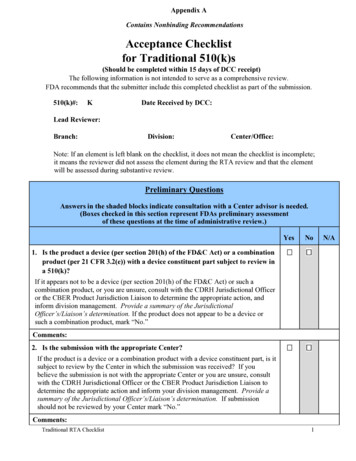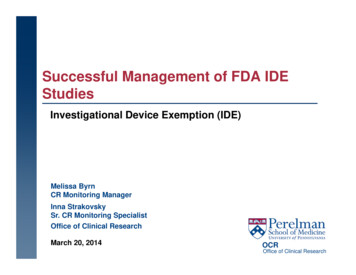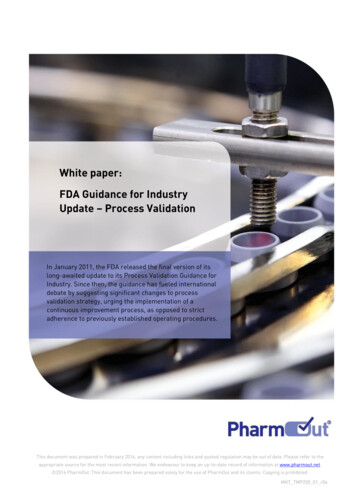
Transcription
White paper:FDA Guidance for IndustryUpdate – Process ValidationIn January 2011, the FDA released the final version of itslong-awaited update to its Process Validation Guidance forIndustry. Since then, the guidance has fueled internationaldebate by suggesting significant changes to processvalidation strategy, urging the implementation of acontinuous improvement process, as opposed to strictadherence to previously established operating procedures.This document was prepared in February 2016, any content including links and quoted regulation may be out of date. Please refer to theappropriate source for the most recent information. We endeavour to keep an up-to-date record of information at www.pharmout.net. 2016 PharmOut. This document has been prepared solely for the use of PharmOut and its clients. Copying is prohibited.MKT TMP200 01 r06
PharmOut white paper: FDA Guidance for Industry Update – Process ValidationIntroductionThe United States Food and Drug Administration (FDA) is responsible for assuring the safety,efficacy, and security of products sold in the USA in the categories of human and veterinarydrugs, biological products, medical devices, cosmetics, and products that emit radiation. Tofacilitate this purpose, the FDA issues guidance documents for auditors and industry to helpdefine the practical expectations of meeting the US GMP regulations.In January 2011, the FDA published an updated guidance entitled Guidance for Industry Process Validation: General Principles and Practices. This document replaces the FDA’s 1987guidance document, Guideline on General Principles of Process Validation.The 1987 document was written when process validation was a relatively new concept to theindustry, which has now evolved in the 20 years between the publications. The new versionbrings the guidance document into the 21st century by including evolutionary developments, aswell as introducing the newest concepts in process validation.Unlike the Codes of Federal Regulations (CFR), FDA guidance documents are not legallybinding, and alternative approaches are acceptable provided they satisfy the requirements ofthe applicable regulations. They do, however, provide the best information on the currentthinking of the regulator, and following them goes a long way to ensuring compliance.Who is affected by the changes?Manufacturers will be directly affected by the changes if they sell products into FDA regulatedmarkets in the following categories: Human drugs Veterinary drugs Biological and biotechnology products Drug constituent of a combination drug/deviceBoth finished product and active pharmaceutical ingredient (API) manufacturers are affected.While not directly affected, manufacturers of products in the above categories who are notcurrently regulated by the FDA can still benefit from this new guidance, which represents upto-date thinking from one of the world’s key regulators.PharmOut Pty Ltd, ABN: 85 117 673 766, Unit 10, 24 Lakeside Drive, Burwood East, Victoria 3151.Ph: 61 3 9887 6412, Fax: 61 3 8610 0169, Email: info@pharmout.net Web: www.pharmout.net 2016 PharmOut. This document has been prepared solely for the use of PharmOut and its clients. Copying is prohibited.Page 2 of 10MKT TMP200 01 r06
PharmOut white paper: FDA Guidance for Industry Update – Process ValidationManufacturers of the following product types are specifically excluded from the scope of theguidance. Where alternative guidance or regulation is used by the FDA, it has been specified:Product TypeRelevant Guidance/RegulationsType A medicated products (articles and feed)for animal useNAMedical devicesGlobal Harmonisation Task Force SG3/N9910: Quality Management Systems – ProcessValidation Guidance ed. 2 (2004)Dietary supplementsNAHuman tissueFDA Guidance for Industry: Validation ofProcedures for Processing of Human TissuesIntended for Transplantation (March 2002)What are the key changes in the new guidance?The updated guidance is virtually a complete rewrite of the 1987 document. There is very littleretained wording from the original, although the general intent of the documents is similar. Insaying this, there are several key points of difference, from the formal definition of processvalidation, to emphasis on product life cycle and risk management concepts. The keydifferences are explained below.Process Validation DefinitionFor years, many in the industry have been able to recite the FDA’s 1987 definition of processvalidation. The 2011 guidance has updated the definition and shifted the focus fromdocumentation to “scientific evidence” throughout the product life cycle.1987 Definition2011 Definition“establishing documented evidence whichprovides a high degree of assurance that aspecific process will consistently produce aproduct meeting its pre-determinedspecifications and quality characteristics”“the collection and evaluation of data, from theprocess design stage throughout production,which establishes scientific evidence that aprocess is capable of consistently deliveringquality products”In the past, process validation emphasis has been on collecting large quantities of data fromvalidation batches, leading to a perception of process validation as largely a documentationexercise.The updated approach requires the manufacturer to collect data throughout the product lifecycle and evaluate it scientifically and assess if it supports a quality process.PharmOut Pty Ltd, ABN: 85 117 673 766, Unit 10, 24 Lakeside Drive, Burwood East, Victoria 3151.Ph: 61 3 9887 6412, Fax: 61 3 8610 0169, Email: info@pharmout.net Web: www.pharmout.net 2016 PharmOut. This document has been prepared solely for the use of PharmOut and its clients. Copying is prohibited.Page 3 of 10MKT TMP200 01 r06
PharmOut white paper: FDA Guidance for Industry Update – Process ValidationFocus on alignment with ‘product lifecycle’The FDA is a party to the International Conference on Harmonisation (ICH) for humanpharmaceuticals. The ICH publishes guidelines on quality, safety, efficacy and multidisciplinarytopics. Quality guidelines Q8 (Pharmaceutical Development), Q9 (Quality Risk Management) andQ10 (Pharmaceutical Quality System) are directly referenced in the new FDA guideline.The FDA has also referenced the ASTM E25001, where the focus has shifted from validation ofindividual parts of a process, to a collective ‘process validation’ effort that takes a more holisticview of process, highlights the GxP critical parts of the process and focuses efforts andresources on the most critical aspects.Of specific importance to the validation guidance is the concept, detailed in these qualityguidelines, of ’product lifecycle‘. The new guidance has been aligned with this concept, givingthe following three-stage approach to process validation: Stage 1 – Process Design Stage 2 – Process Qualification Stage 3 – Continued Process Verification.The guidance provides specific examples of what sort of validation activities are expected ateach stage. Each stage is briefly summarized in the table below.StageIntentTypical ActivitiesProcessDesignTo define the commercialprocess on knowledge gainedthrough development andscale up activitiesA combination of product and process design(Quality by Design)The outcome is the design ofa process suitable for routinemanufacture that willconsistently deliver productthat meets its critical qualityattributesProduct development activitiesExperiments to determine processparameters, variability and necessarycontrolsRisk assessmentsOther activities required to define thecommercial processDesign of Experiment testingProcessQualificationTo confirm the processdesign as capable ofreproducible commercialmanufacturingFacility designEquipment & utilities qualificationPerformance qualification (PQ)*Strong emphasis on the use of statisticalanalysis of process data to understandprocess consistency and performancePharmOut Pty Ltd, ABN: 85 117 673 766, Unit 10, 24 Lakeside Drive, Burwood East, Victoria 3151.Ph: 61 3 9887 6412, Fax: 61 3 8610 0169, Email: info@pharmout.net Web: www.pharmout.net 2016 PharmOut. This document has been prepared solely for the use of PharmOut and its clients. Copying is prohibited.Page 4 of 10MKT TMP200 01 r06
PharmOut white paper: FDA Guidance for Industry Update – Process ValidationStageIntentTypical ActivitiesContinuedProcessVerificationTo provide ongoingassurance that the processremains in a state of controlduring routine productionthrough quality proceduresand continuous improvementinitiatives.Proceduralised data collection from everybatch.Data trending and statistical analysisProduct reviewEquipment and facility maintenanceCalibrationManagement review and production stafffeedbackImprovement initiatives through processexperience* The term “Performance Qualification” or PQ in the new guidance equates to the term“Process Performance Qualification” from the 1987 guidance . This term is analogous with thetraditional concept of “process validation”, as multiple batches of product made at commercialscale under commercial manufacturing conditions. It is not the same as the concept of“equipment performance qualification”.Ramifications of the validation product lifecycleThe life cycle approach to validation has significant impact on manufacturers who previouslyhave seen validation as a discreet effort at the commencement of product commercialization.For many companies, core validation activities have been IQ, OQ, PQ and 3 process validationbatches. The FDA is keen to move firms away from this thinking. Indeed the guidance states:“Focusing exclusively on qualification efforts without also understanding the manufacturingprocess and associated variations may not lead to adequate assurance of quality.”Verifying adequate assurance of quality will involve assessment of all three stages described inthe guidance. This will significantly increase emphasis on pre- qualification activities such asproduct development, as well as assessment of procedures for, and results of ongoing processverification.PharmOut Pty Ltd, ABN: 85 117 673 766, Unit 10, 24 Lakeside Drive, Burwood East, Victoria 3151.Ph: 61 3 9887 6412, Fax: 61 3 8610 0169, Email: info@pharmout.net Web: www.pharmout.net 2016 PharmOut. This document has been prepared solely for the use of PharmOut and its clients. Copying is prohibited.Page 5 of 10MKT TMP200 01 r06
PharmOut white paper: FDA Guidance for Industry Update – Process ValidationWhat has happened to the concept of IQ, OQ and PQ for equipment?It has widely been recognized that there is no mention of the terms installation, operational or(equipment) performance qualification in the new guidance. Does this mean that equipment IQ,OQ and PQ are no longer required?The answer is both yes and no! Yes, in that there is no expectation expressed in the guidance forthe preparation of three stages of qualification documents for critical equipment. No, in thatthere is a clear expectation that equipment will be qualified, and that the qualification willinclude all the aspects that have traditionally fallen into the IQ/OQ/PQ categorization.The new guidance shifts the focus from completing a suite of qualification documents, toensuring that equipment and utility qualification activities are appropriate and complete.While there is now less focus on what equipment qualification activities are called, there is littledifference between the requirements of the old and new guides, as illustrated in the tablebelow.1987 guide2008 guideDescribes “Installation Qualification” which,in practical terms, refers to IQ, OQ andarguably equipment PQ. The 1987 guidedoes not mention OQ or equipment PQ.Describes “Equipment Qualification” which, inpractical terms, refers to IQ, OQ and equipmentPQ.Describes “Process PerformanceQualification” which, in practical terms,refers to equipment PQ (if not previouslycovered) and prospective process validationbatches.Describes “Process Performance Qualification”which, in practical terms, refers to prospectiveprocess validation batches.The golden three batchesAlthough not expressly stated in the old guidance, manufacture of three batches for processvalidation has become industry standard. For some time now, the FDA has been trying to steermanufacturers away from this thinking, and to be more critical in determining how manybatches are required for effective process validation.The new guidance makes it clear that it is the manufacturer’s responsibility to provideassurance that the process is adequately qualified. The use of statistical methods to provideobjective evidence of this is strongly recommended.In practice, this may mean that 3 batches is sufficient to provide the necessary data, or it may bethat more are required (it is unlikely to be less). The manufacturer needs to assess, justify andclearly state those requirements during the preparation of the PQ protocol.PharmOut Pty Ltd, ABN: 85 117 673 766, Unit 10, 24 Lakeside Drive, Burwood East, Victoria 3151.Ph: 61 3 9887 6412, Fax: 61 3 8610 0169, Email: info@pharmout.net Web: www.pharmout.net 2016 PharmOut. This document has been prepared solely for the use of PharmOut and its clients. Copying is prohibited.Page 6 of 10MKT TMP200 01 r06
PharmOut white paper: FDA Guidance for Industry Update – Process ValidationRevision of worst-case conceptThe concept of worst-case conditions for process validation was a key theme of the 1987guidance. The 1987 guidance defines worst-case as:“A set of conditions encompassing upper and lower limits and circumstances, including thosewithin standard operating procedures, which pose the greatest chance of process or productfailure when compared to ideal conditions.”Attempting to cover worst-case conditions in process validation would often mean thatparameters applied to validation batches bore little resemblance to the standard conditions. Asa result, it has been more common that the worst-case concept is given scant considerationwithin process validation exercises.The 2
Process Validation: General Principles and Practices. This document replaces the FDA’s 1987 guidance document, Guideline on General Principles of Process Validation. The 1987 document was written when process validation was a relatively new concept to the industry, which has now evolved in the 20 years between the publications. The new version brings the guidance document into the 21st .
